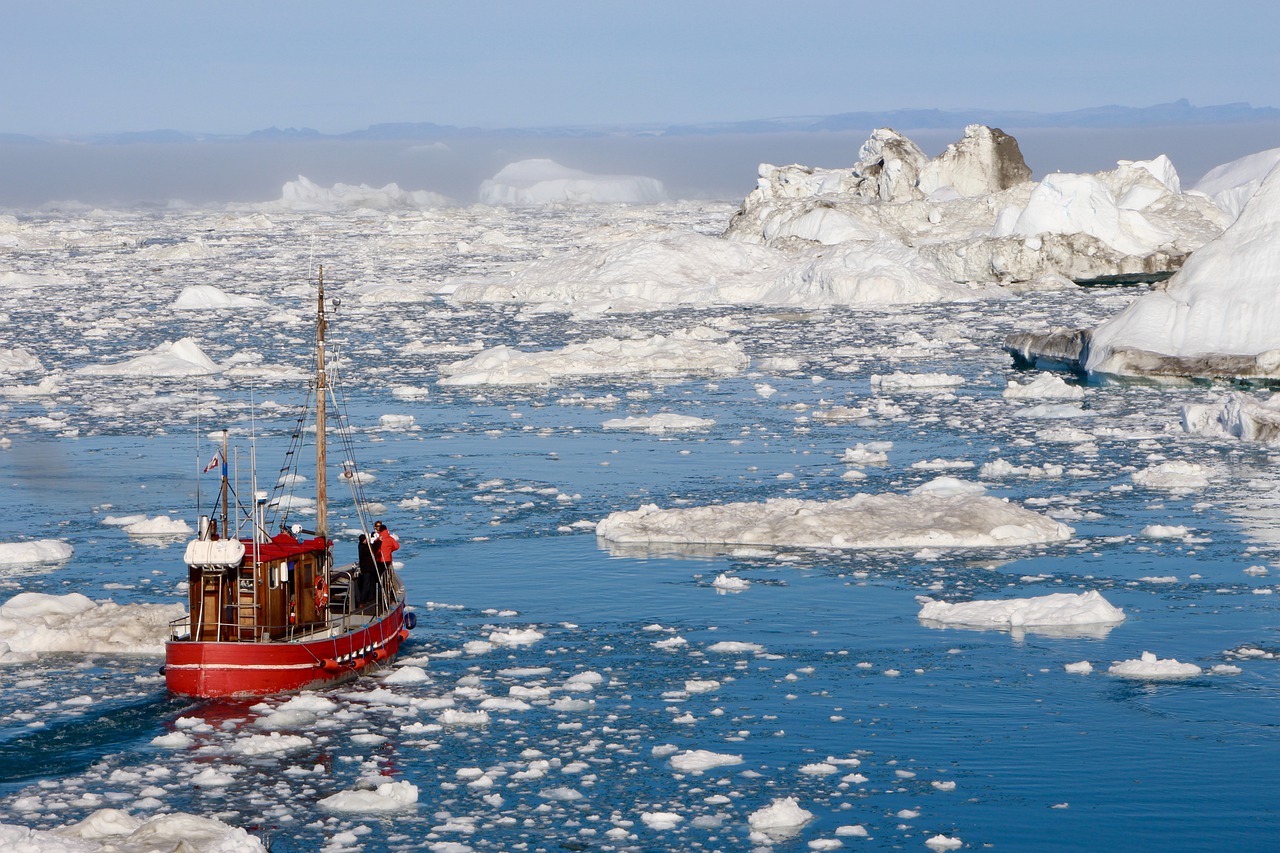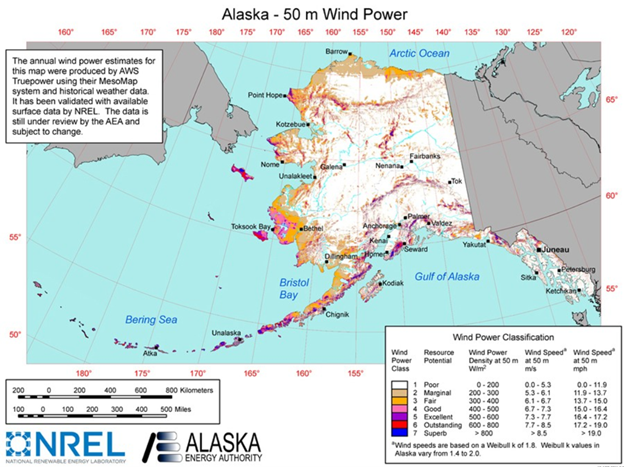
Renewable Energy as a National Security Strategy in the Arctic
The Arctic region is at the intersection of climate security, energy security, and great power competition, which presents a complex national security challenge for the United States. On average, Arctic sea ice is decreasing by about 13.1% every decade; the cause is climate change. This ice melt is opening up new potential trade routes and providing access to previously inaccessible natural resources. The Arctic is estimated to hold approximately 13% of the world’s undiscovered oil supply and 30% of its untapped natural gas. Combined with the potential for wind, solar, geothermal energy, and new trade routes, the Arctic is increasingly gaining global attention, particularly from Russia and China. This all makes the Arctic a vital geostrategic location for U.S. national security. However, the U.S. is at a disadvantage in the region compared to our adversaries because of historic stagnation in Arctic policy that prevented substantial long-term investment into the region. The U.S. must develop a strategy for expanding its Arctic presence and its role as a regional leader. Expanding renewable energy infrastructure in the Arctic may not just help address climate change but is a vital strategy for maintaining national security in a constantly warming Arctic.
Arctic Adversaries
Russia
The Arctic has long been a focus of Russian economic development. According to the Russian Finance Ministry, in 2018 oil and gas revenue contributed to approximately 45% of Russia’s entire budget. However, Russia obtains approximately 95% of its natural gas and 75% of its oil from the Arctic. This means that the region is vital to the Russian economy. Russia’s gas reserves are primarily in western Siberia, Bashkortostan, Komi and Tatarstan, but these reserves are quickly depleting. Consequently, as climate change melts Arctic ice, Russia is seeking to capitalize on these regions through new fossil fuel projects. Moreover, Russia is seeking to accelerate its Arctic fossil fuel projects in anticipation of a global oil demand drop due to environmental policies. In April 2021, the State Duma approved a new oil strategy focusing on maximizing revenue from its crude exports and hitting peak production rates in 2027-2029. Pavel Zavalny, head of the State Duma’s energy committee stated: “Everything that can be produced should be produced while there is still demand to sell it.” Beyond just increasing oil production for the short term, Russia has a long-term interest in the region as it sees liquid natural gas (LNG) as the main energy solution for climate change, with little interest in developing renewable energy technologies. Russian Minister of Development for the Far East and the Arctic, Aleksey Chekunkov, stated:
“We have to be realistic; we are the largest country in the world. Solar is not an option for the Arctic region and wind energy isn’t constant…we need to be realistic about the size of the country. Building a grid for a land that has on average one person per square kilometer is not always economic. Unless we see a major breakthrough in the technology of batteries and on moving power from one place to another, I believe LNG is the best possible solution”
People’s Republic of China
In January 2018, China released a white paper on its Arctic policy clearly stating its interests in the region and the intent to pursue them. Included in China’s Arctic policy was a strategy to capitalize on opening trade routes by building a “Polar Silk Road” under its current Belt and Road Initiative. However, even before the release of its Arctic policy, China has been heavily investing in Arctic states with a focus on mineral resources and fossil fuel projects. In addition, China built its first domestic icebreaker and announced plans to build a nuclear powered icebreaker.
Perhaps most concerning is the increasing Russian-Sino economic partnership manifesting in the Arctic. An example of this is Russia’s Arctic LNG 2 project. The Chinese Development Bank contributed $5 billion to the project, the highest amount of any foreign investor. Additionally, Russian gas company Novatek has signed a 15-year deal with Chinese owned Shenergy Group to allocate 3 million tons of LNG from this project to the company.
Oil and Gas in the Arctic
While climate change concerns have accelerated Russia’s fossil fuel plans for the Arctic, they have largely had the opposite effect on American fossil fuel efforts in the region. Between concerns over the effects of fossil fuel projects on the indigenous population and political disagreements over climate change, fossil fuel investment has largely struggled to gain traction when compared to Russia. For example, U.S. Arctic policy went through drastic changes between the Bush, Obama and Trump presidencies. Obama reversed many of Bush’s policies to extract oil in the Arctic because of climate change concerns, however Trump reversed Obama’s policies and began pushing for oil extraction. This lack of continuity negatively affected any US attempt to build lasting infrastructure to capitalize on petroleum resources in the Arctic. This battle extends into the present day. In August 2020, the Trump administration announced plans to open up parts of the Arctic National Wildlife Refuge (ANWR) in Alaska to oil and gas development. However, the auction was met with little interest, with only three companies offering bids for oil drilling. The opening of the ANWR to oil drilling was immediately reversed when the Biden administration took office. But this lack of interest in the ANWR demonstrated that even with regulations rolled back, there is little interest from American oil companies to drill in the Arctic. This is especially true considering the more easily accessible oil reserves located in Texas.
Renewable Energy as a National Security Strategy

Alaska 50-Meter Community-Scale Wind Resource Map, Photo Credit Department of Energy
Alaska has incredible potential for renewable energy production. The U.S. should focus on expanding renewable energy in the Arctic not only to meet its climate change goals, but as a national security strategy to counter growing Russian and Chinese influence in the region. Alaska’s coasts are abundant in untapped wind resources. Renewable energy accounts for 30% of Alaska’s electricity generation as of 2019, but only about 8% of this is from wind energy. The map above, provided by the Department of Energy, outlines the potential for coastal wind generation on Alaska’s coasts. Furthermore, despite Alaska’s long winters and nights, solar energy is an increasingly valuable energy source for off-grid applications in remote areas. Exploring wind and solar production in Alaska can benefit U.S. national security in two main ways:
First, The U.S. can use renewable energy infrastructure to justify an increased U.S. presence, in a similar manner that Russia uses oil and gas. Establishing a sustainable structure of microgrids and renewable energy production will take both time and resources, of which the United States can use as platforms for increased power projection through military outposts. This will allow the US to increase power projection in the Arctic and help mitigate a Russian response by providing both a valid reason for increased US forces and a method to gradually increase military presence, rather than give the appearance of a rapid military buildup. Moreover, climate change is negatively impacting current military infrastructure. Alaska is home to multiple military bases and infrastructure, which are currently being damaged by thawing permafrost and coastal erosion, which changes the landscape and damages this infrastructure. The U.S. needs to maintain this infrastructure, similar to Russia’s renovations of its Arctic military infrastructure.
Second, effectively scaling wind and solar energy will likely take intercountry collaboration with Canada. Also, the Arctic is becoming a long-term strategic interest and the U.S. will likely need regional security partners, strengthening the need to collaborate with our northern neighbors. Canada is a close Arctic ally and faces many of the same national security risks. The U.S. and Canada can use renewable energy infrastructure projects as a mechanism to build a closer security partnership in the Arctic region. This will provide a more sustainable solution for both the U.S. and Canada, as it will lessen the resource burden of maintaining national security in the Arctic and provide a partnership to counter growing Russian-Sino influence.





